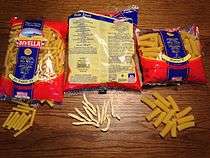Bucatini
|
| |
| Alternative names | Perciatelli |
|---|---|
| Type | Pasta |
| Place of origin | Italy |
| Main ingredients | Durum wheat flour, water |
| Variations | ziti, zitoni |
|
| |
Bucatini [bukaˈtiːni], also known as perciatelli [pertʃaˈtɛlli], is a thick spaghetti-like pasta with a hole running through the center. The name comes from Italian: buco, meaning "hole", while bucato or its Neapolitan variant perciato means "pierced".[1][2]
Bucatini is common throughout Lazio, particularly Rome. It is a tubed pasta made of hard durum wheat flour and water. Its length is 25–30 cm (10–12 in) with a 3 mm (1/8 inch) diameter. The average cooking time is nine minutes. In Italian cuisine, it is served with buttery sauces, pancetta or guanciale, vegetables, cheese, eggs, and anchovies or sardines.
Similarly, ziti [ˈdziːti] are long hollow rods which are also smooth in texture and have square-cut edges; "cut ziti" are ziti cut into shorter tubes.[3] There is also zitoni [dziˈtoːni], which is a wider version of ziti.[4]
- Bucatini all'amatriciana, a dish prepared with bucatini pasta
 Size comparison between cut ziti, fusilli Avellinesi and rigatoni
Size comparison between cut ziti, fusilli Avellinesi and rigatoni
See also
References
- ↑ Giacomo Devoto, Gian Carlo Oli, Il Devoto-Oli. Vocabolario della lingua italiana, edited by Luca Serianni and Maurizio Trifone, Le Monnier.
- ↑ "Perciare in italiano". Glosbe - Il dizionario multilingue on line. Retrieved 2015-11-16.
- ↑ "Cook's Thesaurus: Pasta Tubes". Foodsubs.com. Retrieved 2013-02-21.
- ↑ "Type Of Pasta". Thenibble.com. Retrieved 2013-02-21.